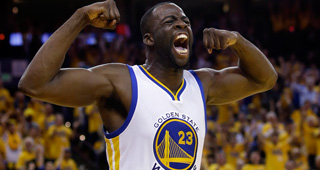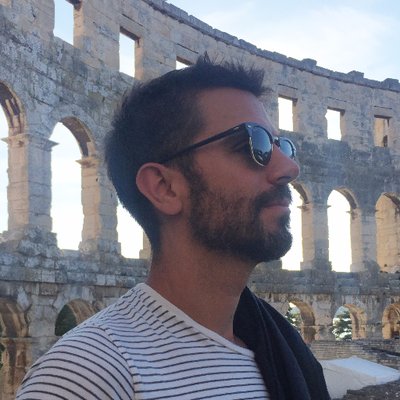As with anything, success brings out eager, excitable imitators. The Golden State Warriors have the two best shooters in the NBA and the delusion is that even if a team can play fast while maintaining a top-5 defense, attempt a ton of three’s while approximating the shooting of Stephen Curry and Klay Thompson, you will still be a Draymond Green short.
Green does everything on the floor while also being versatile enough to physically do it at multiple positions against all kinds of different players, and he does it with an innate and merciless toughness. The combination turned a second round pick between positions and a little overweight into a top-15 player in the NBA and the impeccable complement to empower Curry and Thompson as they turn basketball into archery as Colin McGowan wrote this week. Most small ball lineups in the NBA sacrifice defense and rebounding, but the Warriors really don't with Green at center.
As Green watched Game 5 from a the suite of a baseball game with Marshawn Lynch and the Warriors were run off the floor in the second half, I couldn’t help but think back upon a piece Jonathan Tjarks wrote in 2014 on how it was Shawn Marion that made Steve Nash better and not the opposite.
As Tjarks writes, Marion would routinely defend the opponent's best scorer whether it was Dirk Nowitzki or Tony Parker. Marion gave cover to Nash and Amar’e Stoudemire on defense while getting out of their way on offense and taking his man with him to the three-point line to create space because his unorthodox shot had to be challenged. Like Green, Marion played bigger than he was against bigs and smaller than he was against smalls and he was always up to contribute in every aspect of the game.
While Green and Marion are incredibly different players stylistically and aesthetically, they function in similar ways and facilitate the system. With his outsized personality, how much Curry defers credit and the very nature of how we consume sports on social media, Green has received an appropriate level of praise for his value that eluded Marion in most areas of the basketball world. There are quite clearly no back-to-back MVPs for Nash and Curry without Marion and Green. Nash grew into that role by joining Marion in 2004 while Curry went from an All-Star to a historically great offensive player almost immediately after Golden State replaced David Lee with Green.
As great as Marion was, Green has three added elements that as made the Warriors far better than those Suns’ teams in both the regular season and more importantly in the playoffs:
1. Rim Protection
2. Holding up physically at center
Green is stronger and bulkier than Marion, allowing him to not be backed down in the post against just about anyone.
3. Passing
Green had an assist rate of 29.0 percent, allowing the Warriors to play 4-on-3 in the pick-and-roll when it is trapped and just generally allow both Curry and Thompson to play off the ball more than they would on a normal team.
Before Game 5, there were at least a few of us saying that it would be more difficult for the Warriors to beat the Cavaliers without Green than without Curry. Green has played in all 88 of the Warriors’ wins this season while they’ve won six playoffs games that Curry either didn’t appear in or didn’t finish. It is a counterintuitive concept to understand but Curry can be the MVP of the NBA while also being more easily replaceable than Green.
The Warriors managed their roster strangely this season when they added Anderson Varejao after the trade deadline since they already had three centers in Andrew Bogut, Festus Ezeli and Marreese Speights before even factoring in the Death Lineup with Green taking minutes at center. Drafting Kevon Looney as an approximation of Green down the road was a smart move but their only other traditional power forward is James Michael McAdoo.
Green is a once in a generation blend of Charles Barkley and LeBron James with the duties and talent level of a role player and there’s no replacing him but he doesn’t even have a rotation-level backup beyond sliding Harrison Barnes from small forward all the way up to center, which the Warriors tried in Game 5. Barnes has been a disappointment in just about every way imaginable since leaving Ames, Iowa for North Carolina but his own blend of versatility in defending small forwards and bigs plus just enough shooting to make him viable will likely lead to one of the most confusing max contracts of all-time to non-serious NBA fans.
Similar to how easy it felt for the Warriors in Games 1 and 2 of The Finals on offense not playing against the extreme length of the Thunder, the Cavaliers had the same experience in Game 5 against the Warriors without trying to score against Green.
There are teams like the Blazers with Damian Lillard and C.J. McCollum, Wizards with John Wall and Bradley Beal, maybe in a few years the Lakers with D’Angelo Russell and Jordan Clarkson that really like their guard play to adopt a version of the Warriors’ success, but they will all likely find that the Draymond Green gadget to turn them into a title contender is the most difficult weapon to find. While you can play entertaining, high variance basketball this way, it is unwise to expect anything beyond the first or second round of the playoffs.
What's more likely is a team builds it the other way with shooters added as role players to complement a better version of Green like Karl-Anthony Towns and Anthony Davis. If a LeBron James' team at any point in the last decade was built like that, they would have won 75. If there's ever going to be a team that becomes the iPhone to the Warriors' Blackberry, it will come when the player in the Draymond Green role is the MVP of the entire league.



